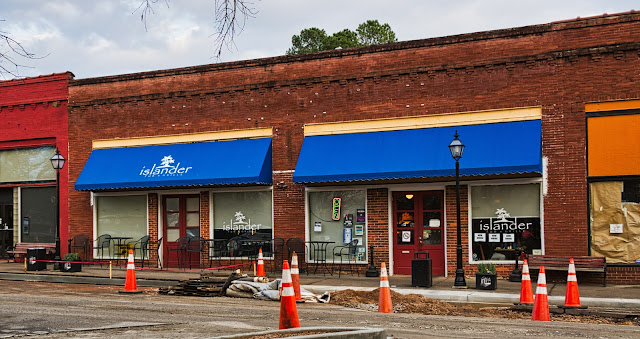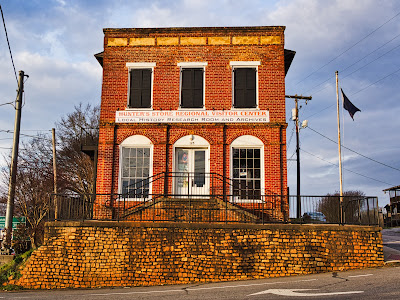A Late Afternoon Walk Around Pendleton
The first Wednesday of every month, the meetup group Tri-County Adventure Group (Hike, Paddle & More!) meets at a restaurant in the Oconee, Pickens, and Anderson County area to meet and discuss upcoming adventure meetups. This month's meetup took place at the Islander Pub and Grille on Exchange Street in Pendleton. Since I had to take the whole day off to attend this meetup, I traveled down to Pendleton a few hours early to walk around to see a few historic points of interest in this small town.
Pendleton District was created in 1789 and covered the present day counties of Oconee, Pickens, and Anderson. Pendleton was established in 1790 as the seat of Pendleton District and a courthouse built. Both Pendleton District and the town of Pendleton were named after Henry Pendleton, a circuit court judge originally from Virginia. In 1826 while a second courthouse was being built, Pendleton District was abolished and replaced by Pickens District and Anderson District. Pickens District would later be divided into Pickens County in Oconee County in 1868. MapOfUs.org has a handy interactive map of South Carolina showing the many changes to South Carolina's county boundaries over the years.
Pendleton was important as a summer destination for wealthy plantation owners from the Low Country by 1800, and that continued into the mid 1800s. The Blue Ridge Railroad was completed from Anderson to Pendleton to West Union by 1859. The original plans called for the railroad to extend up to Knoxville, Tennessee, but the cost of the many tunnels (and fraud and other reasons) doomed the project. The partially completed Stumphouse Tunnel is one famous result of the failed project.
I didn't have time to visit every historical site in town, but I did manage to visit quite a few in the time I had before I ran out of time.
During my first visit, I somehow didn't take a photo of the date marker:
I had also missed the grave of General Andrew Pickens:
Source: South Carolina Digital Library
The bottom floor is now home to the 1826 Bistro:
Source: South Carolina Digital Library
The first floor is currently used by the Pendleton Historic Foundation. The second floor is currently the magistrate's office.
The warehouse for Hunter's Store, now behind Vaqueros Mexican Restaurant, was built in 1880.
Keese Barn was an antiques store built in 1910 (with cafe added soon after) owned by Ben Keese (1871-1975). The store shut down in the 1970s and Keese Barn fell into disrepair. The Pendleton Foundation for Black History and Culture bought the property in 1975 in hopes of preserving the structure. Efforts to raise enough money to preserve the structure failed, so it was taken down. Parts of the old structure were reused by Clemson University architecture students to build a memorial in 2003.
The depot has been recently used as a senior center, but now the train depot building is currently an office for the Clemson Anderson Soccer Alliance.
I've uploaded my trip photos to an album on Google Photos for your usual viewing displeasure.
Pendleton District was created in 1789 and covered the present day counties of Oconee, Pickens, and Anderson. Pendleton was established in 1790 as the seat of Pendleton District and a courthouse built. Both Pendleton District and the town of Pendleton were named after Henry Pendleton, a circuit court judge originally from Virginia. In 1826 while a second courthouse was being built, Pendleton District was abolished and replaced by Pickens District and Anderson District. Pickens District would later be divided into Pickens County in Oconee County in 1868. MapOfUs.org has a handy interactive map of South Carolina showing the many changes to South Carolina's county boundaries over the years.
Pendleton was important as a summer destination for wealthy plantation owners from the Low Country by 1800, and that continued into the mid 1800s. The Blue Ridge Railroad was completed from Anderson to Pendleton to West Union by 1859. The original plans called for the railroad to extend up to Knoxville, Tennessee, but the cost of the many tunnels (and fraud and other reasons) doomed the project. The partially completed Stumphouse Tunnel is one famous result of the failed project.
I didn't have time to visit every historical site in town, but I did manage to visit quite a few in the time I had before I ran out of time.
Old Stone Church and Cemetery
Before heading into downtown Pendleton I paid another visit to Old Stone Church and Cemetery just outside of Pendleton on Stone Road.During my first visit, I somehow didn't take a photo of the date marker:
I had also missed the grave of General Andrew Pickens:
Ruins of Tanglewood Mansion
As early as the 1830's, the site of Tanglewood Mansion was the site of a residence. In 1860, John and wife Mollie Sloan established a home now known as Tanglewood. That home burned in 1908, but was rebuilt two years later, reusing some of the columns. Tanglewood remained in the Sloan family until the 1950s, when the home was sold. The home burned down again in 1970 and this time it stayed burned down. In 2004, the owners of the property sold the ruins to the Anderson County Library System, and the Pendelton Branch Library now sits next door.Farmers Hall
The Farmers Hall building sits in downtown Pendleton on the town's village green off Exchange Street. The Pendleton Farmers Society organized in 1815, meeting in a log cabin from 1816 until 1828. When the state decided to split Pendleton District into Pickens District and Anderson District in 1826, a new courthouse was already under construction. The Pendleton Farmers Society bought the partially completed structure and completed it in 1828. The bottom floor was at one time a post office.Source: South Carolina Digital Library
The bottom floor is now home to the 1826 Bistro:
Guard House and Library
The Guard House was built in 1860 on the site of the old town jail a short distance north of Farmers Hall. The building later served as the town library.Source: South Carolina Digital Library
The first floor is currently used by the Pendleton Historic Foundation. The second floor is currently the magistrate's office.
Hunter's Store and Warehouse
The Hunter's Store building, at the corner of North Mechanics Street and East Queen Street, was built by John Lewis in 1850 as a general store. The Hunter family operated the store in this location from 1873 until 1929, when the business moved next door to where Vaqueros Mexican Restaurant is now. The building was mostly empty until 1968 when the newly formed Pendleton Historic Preservation Commission assumed ownership.The warehouse for Hunter's Store, now behind Vaqueros Mexican Restaurant, was built in 1880.
Pendleton Theater
The Pendleton Theater on South Mechanic Street showed movies during World War 2 but closed shortly after the war ended according to Cinema Treasures. After being owned by a series of businesses, the Clemson Little Theatre bought the old theater in 1989, renovated it, and has been performing there since 1992.Jones' Rifles
Near the corner of South Mechanic Street and Cherry Street is the building once home to the Civil War headquarters of Jones' Rifles. It was built in 1840 as a blacksmith shop and iron forge works. The building currently appears to be vacant. The last occupant appears to have been Whitfield Gallery.Mural
Painted on the side of the building at 175 North Mechanic Street facing West Queen Street is a mural by Lori Solymosi depicting several historic homes and churches in Pendleton.Keese Barn Memorial
Where West Queen Street splits into two one-way streets is a memorial to Keese Barn.Keese Barn was an antiques store built in 1910 (with cafe added soon after) owned by Ben Keese (1871-1975). The store shut down in the 1970s and Keese Barn fell into disrepair. The Pendleton Foundation for Black History and Culture bought the property in 1975 in hopes of preserving the structure. Efforts to raise enough money to preserve the structure failed, so it was taken down. Parts of the old structure were reused by Clemson University architecture students to build a memorial in 2003.
Printer John Miller House
On North Broad Street off East Queen Street is the house of John Miller who came to Charleston, South Carolina from London and became publisher of the state's first daily newspaper in 1783. In Pendleton, he published Miller's Weekly Messenger, the Upstate's first newspaper.Pendleton Depot
The Pendleton Depot was moved from where it once served passengers off East Blue Ridge Street to its current location on Cherry Street. The move occured sometime between 1978 and 1994. Railroad Picture Archives has two photos, both from 1978, showing the depot at its original location. One shows the depot and a caboose. The other shows the depot and a locomotive. A 1994 aerial shows the depot no longer at its original location.The depot has been recently used as a senior center, but now the train depot building is currently an office for the Clemson Anderson Soccer Alliance.
Pendleton Oil Mill
Pendleton Oil Mill was a mill complex for extracting oil from cotton seeds to make cottonseed oil on both sides of East Main Street. The Sutton family opened a cotton gin here in the 1860s. A cottonseed mill was built here sometime later, possibly by 1900. When the mill closed down in the 2000s, the mill was producing fertilizer. The mill has been decaying for some time and the EPA has recently taken interest in the site. In July 2015, part of the mill collapsed and briefly blocked the adjacent railroad track.Wrapup
By the time I made it to the Pendleton Oil Mill, it was getting dark and it was almost time for the meetup at Islander Pub and Grille. I took a few photos then I headed back to downtown. I got to see some great people I haven't seen in a quite a while, other great people I've seen just recently, and some other great new folks I met there.I've uploaded my trip photos to an album on Google Photos for your usual viewing displeasure.




























Comments
Post a Comment